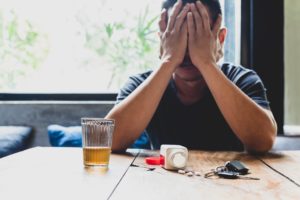Many people today find the everyday sources of stress to be so great that they actually interfere with their ability to rest and sleep. Sometimes the daily stress even induces anxiety, which adds to their difficulty in relaxing and de-stressing at the end of the day.
This is why many people actually need the help of depressants such as benzodiazepines and alcohol. The sad outcome of this, however, is that many develop a heavy dependence on these substances. This overdependence becomes the gateway to an addiction, which is far worse than the stress and anxiety that they need the substances for.
What Are Benzodiazepines and Why Are They Misused?
 Benzodiazepines, or benzos for short, are substances that belong to a class of psychoactive drugs. It functions as a depressant, decreasing brain activity, which helps in treating conditions like insomnia, anxiety, and even seizures.
Benzodiazepines, or benzos for short, are substances that belong to a class of psychoactive drugs. It functions as a depressant, decreasing brain activity, which helps in treating conditions like insomnia, anxiety, and even seizures.
Benzos work by enhancing the effect of gamma-aminobutyric acid (GABA), a neurotransmitter that blocks or inhibits impulses between nerve cells in the brain. When a person is stressed out, excited, or anxious, these nerve cells fire out impulses from the brain in a frenzied manner, although this tends to die down after some time, or when the person becomes less anxious, stressed or excited.
Some people, however, find it quite difficult to bring down their anxiety levels once escalated, and it affects their ability to rest and relax. If left untreated, it also leads to a host of other complications, such as inability to sleep, mood changes, and inability to think clearly.
In these cases, benzos or some other depressant is used to help bring out the sedative properties of the GABA neurotransmitter. The immensely relaxing properties of benzos, however, quickly become habit-forming, resulting in an addiction. Many people say that it brings about a deep dreamless slumber, which could be quite elusive for people who suffer from bouts of anxiety.
Benzos provide stress relief and relaxation about as quickly as the person’s body can absorb them, which is relatively easy as most benzos come in pill form. However, it is also known to be administered intramuscularly, intravenously, nasally (spray), topically, or rectally. Considering the easy delivery system, plus the deeply relaxing effect combined with a moderate sense of euphoria, it really is no wonder why so many are hooked on using benzos.
What Conditions are Treated Using Benzos?
There are a number of different benzos prescribed to treat a variety of conditions, and all of these are approved by the US Food and Drug Administration.
These include:
Alprazolam
Marketed under the brand names Xamax and Xanax XR, alprazolam is a fast-acting tranquilizer. It is primarily used to treat a variety of anxiety disorders, although it is most commonly used in dealing with generalized anxiety disorder (GAD). Used in this manner, alprazolam is observed to bring about an improvement in GAD in just about a week.
Alprazolam is also used in the treatment of chemotherapy-induced nausea.
Chlordiazepoxide
Marketed under the brand name Librium, chlordiazepoxide is a powerful sedative and hypnotic medication. It is used primarily in the treatment of insomnia, and anxiety, and in dealing with the withdrawal symptoms of alcohol addiction and other substances as well.
Chlordiazepoxide is also sometimes used in the treatment of irritable bowel syndrome (IBS) in conjunction with clidinium bromide.
Clonazepam
Clonazepam is marketed under the brand name Klonopin and is primarily used in the treatment of anxiety, panic disorder, seizures, and akathisia. Akathisia is a movement disorder and a neuropsychiatric issue vaguely described by those who suffer from it as feelings of nervousness, uneasiness, unconscious twitches, inability to relax, and restlessness.
It is an orally-administered tranquilizer and its effects typically last between six to twelve hours.
Diazepam
The first diazepam brand commercially available was Valium, although today it is also available as Diastat and Valtoco. It is an anxiolytic or antianxiety treatment used in a number of applications, such as alcohol withdrawal syndrome, insomnia, restless leg syndrome, muscle spasms, and seizures. It could be administered orally, rectally, intravenously, intramuscularly, or nasally (spray).
When taken orally, diazepam typically begins to take effect anywhere from 15 to 60 minutes after ingestion. Taken intravenously, however, it takes effect in as little as one to five minutes. The effects of diazepam could last up to an hour.
Lorazepam
Lorazepam is marketed under the brand name Ativan and is an anxiolytic (antianxiety) medication with potent sedative-hypnotic properties. It is also used in the treatment of sleeping disorders, severe agitation, alcohol withdrawal symptoms, and in chemotherapy-induced nausea and vomiting.
Lorazepam is also used in treating status epilepticus, a form of seizure that is characterized by a single seizure that lasts more than five minutes, or two or more seizures within a five-minute period where the person does not return to normal in the interval between seizures.
This medication is also used to sedate people who are being mechanically ventilated, and during surgery to interfere with memory formation. The effect usually lasts up to a day.
Temazepam
Temazepam is marketed under the brand name Restoril and is used in treating severe or debilitating insomnia. Orally taken, temazepam typically takes effect after thirty minutes and lasts up to eight hours. Being a powerful hypnotic medication, temazepam is typically only prescribed for use for less than ten days.
This strict regulation is due to the fact that temazepam addiction cases are quite high, and most often result in overdose deaths. From the 1980s up to 2010, temazepam is noted to have the highest addiction rates of all benzos.
Triazolam
Marketed under the brand name Halcion, triazolam is a central nervous system (CNS) depressant tranquilizer. It is generally used to treat severe insomnia, and apart from its hypnotic properties, it also has amnesiac, muscle relaxant, anticonvulsant, and anxiolytic properties as well.
It is one of the most prescribed medications of its kind, mainly because of its effective use in treating sleeping disorders, particularly jet lag.
Midazolam
Marketed under the brand name Versed, this medication is primarily used for anesthesia, sleeping disorders, severe agitation, prolonged seizures, acute seizures, and procedural sedation. This medication works to induce sleepiness through sedation, but does not cause a person to become unconscious.
It is fast-acting when taken intravenously, taking effect in as little as five minutes. The effects last anywhere between one and six hours.
Estazolam
Estazolam is marketed under the brand name Prosom and functions as a tranquilizer. It has hypnotic, sedative, anticonvulsant, and anxiolytic properties. It also has skeletal muscle relaxant properties.
Primarily used as a short-term treatment for sleep disorders, estazolam is typically taken orally and compared to other benzos, has a longer half life of about nineteen hours.
Flurazepam
Marketed under the brand names Dalmane and Dalmadorm, this medication is a benzo derivative and has hypnotic, sedative, anxiolytic, and anticonvulsant properties. It also has skeletal muscle relaxant properties.
Flurazepam was one of the very first benzo hypnotics to be marketed as sleeping aids.
Quazepam
Quazepam is marketed under the brand name Doral and has a relatively lower tendency to cause addiction than other benzos. It has uniquely selective hypnotic properties that do not disrupt a person’s normal sleep pattern, and produces less sedation than other benzos.
Quazepam is also used as an effective premedication prior to a medical procedure.
Are Benzos Typically Mixed With Other Substances?
 Physicians always emphasize the danger of combining medications with other substances. Whether intentionally or unconsciously, substances should never be mixed unless specifically instructed by a doctor.
Physicians always emphasize the danger of combining medications with other substances. Whether intentionally or unconsciously, substances should never be mixed unless specifically instructed by a doctor.
As with most abused substances, benzos are often taken with other substances, with the intention of achieving faster and longer effects. This however, could also lead to an increased risk of overdose and even death.
Many mix benzos and alcohol, as both are depressants, with each increasing the sedative effect of the other. Separately, alcohol and benzos already come with potent effects on the mind and on the body:
Effect of alcohol:
- Sedation
- Arrhythmia (irregular heart rate)
- Bradypnea (slowed breathing)
- Impaired motor control
- Impaired coordination
- Impaired cognitive abilities
Effect of benzos:
- Varying degrees of sedation
- Confusion
- Dizziness
- Weakness
- Headaches
- Impaired memory
- Arrhythmia (irregular heart rate)
- Bradypnea (slowed breathing)
With some of the effects of alcohol and benzos being similar, combining the two would serve to magnify these effects to the point where they could become debilitating or even life-threatening. The simple effects of impaired motor control and dizziness could already cause accidents for most people.
How Long After Taking Benzos Should a Person Wait Before a Drink?
Unless specifically indicated by a doctor, it is best not to combine or take two substances one after the other until the first substance taken is already cleared from the system. In the case of alcohol and benzos, these two substances have different half-lives, or the time it takes for the body to get rid of half of what was taken.
Generally speaking, and depending on the physical makeup of the person which includes tolerance and threshold level, the half life of alcohol is around four to five hours. It takes around twenty-five hours, however, to completely clear the body of all traces of the alcohol ingested.
In the case of benzos, however, because it has pronounced effects, the measure should be focused on how long these effects last. Some benzos last only for hours while others could last for days, which should be taken into consideration if one is taking benzos and is planning on having a drink.
These benzos have effects that last anywhere from eleven to twenty hours:
- Alprazolam
- Lorazepam
- Estazolam
- Temazepam
These benzos have effects that last anywhere from one to three days:
- Chlordiazepoxide
- Clonazepam
- Diazepam
- Flurazepam
- Quazepam
What are the Signs of Alcohol and Benzo Abuse?
The most observable signs and symptoms of polysubstance abuse such as benzo and alcohol addiction could be seen in hospitals, because this is mostly where those into it end up. This is because the combined effects of alcohol and benzos make even the most simple of normal tasks, such as walking, nearly impossible.
People who suffer from polysubstance abuse, such as those with a dependency on alcohol and benzos, will primarily suffer from the heavy sedative and hypnotic effects. This will manifest as:
- Slurred speech
- Severely impaired motor control
- Severely impaired coordination
- Prolonged periods of sleep or unconsciousness
- Inability to think
- Coma
It is not uncommon for people who abuse both alcohol and benzos together to suffer from an overdose and even death. This is why it is important for people suffering from a polysubstance abuse issue with these two substances to seek help immediately.
Treatment for Benzodiazepines and Alcohol Abuse
 Treatment begins with detoxing, as there is a need to not only stop the substances from further damaging the body, but also mitigate whatever damage is already done. This is important because there are cases wherein immediate discontinuation of the substances resulted in death. Medical professionals in detoxing and rehabilitation facilities are trained to diagnose and deal with whatever extent the damage might be, and determine whatever steps are needed to lead to a full recovery.
Treatment begins with detoxing, as there is a need to not only stop the substances from further damaging the body, but also mitigate whatever damage is already done. This is important because there are cases wherein immediate discontinuation of the substances resulted in death. Medical professionals in detoxing and rehabilitation facilities are trained to diagnose and deal with whatever extent the damage might be, and determine whatever steps are needed to lead to a full recovery.
Following the detox, further treatment during rehabilitation is needed to prevent any chance of a relapse. People who form a heavy dependency on potent substances such as benzos are prime candidates for relapses because of the highly addictive nature of the substance. Rehabilitation is augmented with support therapy to help the patient build enough confidence and motivation to stay true to their journey to recovery.
A True and Lasting Recovery is Possible with Magnolia City Detox
The greatest hindrance to a lasting recovery is a relapse. With many substance dependencies, it is so easy to slip back into the bad habit, undoing all the progress achieved in rehab.
We here at Magnolia City Detox know this fact intimately, because we have seen it happen, and we know how best to deal with it. See us now and let us help you to a true and full recovery now.

















